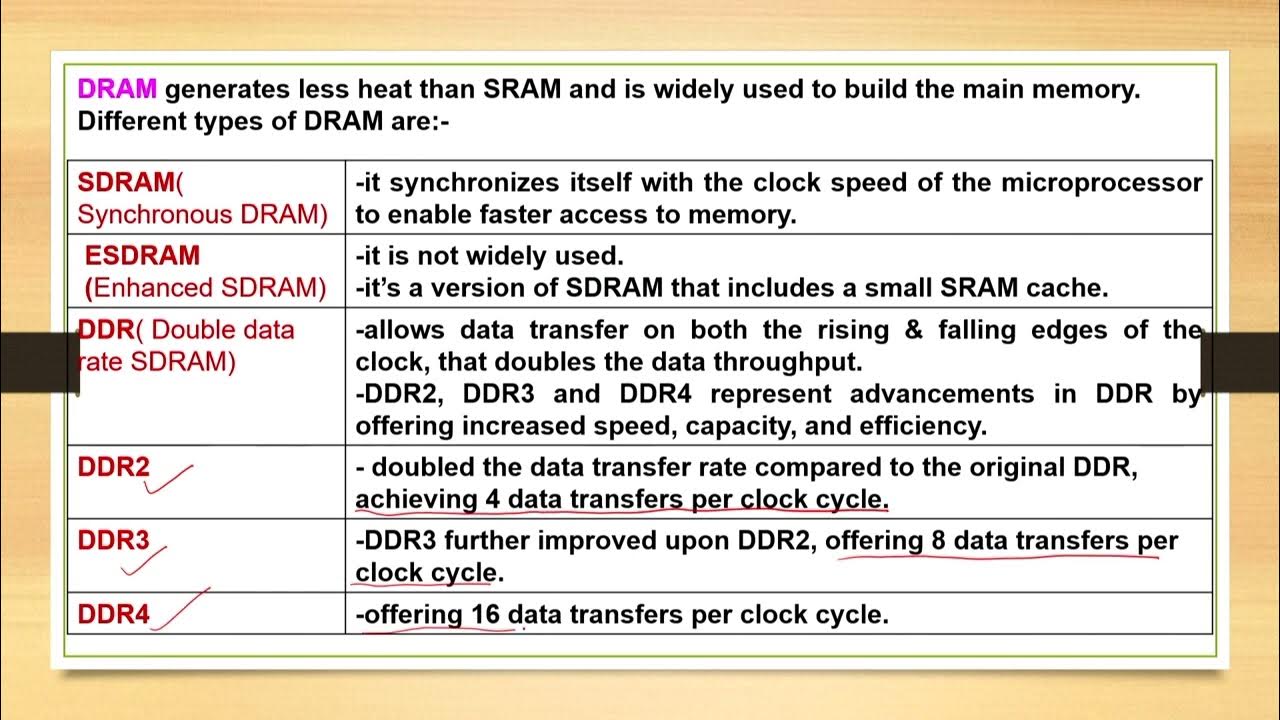6. OCR GCSE (J277) 1.2 The need for primary storage
Summary
TLDRThis video explores the importance of primary storage, focusing on the differences between primary and secondary storage devices. Primary storage includes RAM, ROM, registers, and cache, which are volatile and offer smaller capacity but significantly faster access speeds than secondary storage, like hard drives. The speed advantage of primary storage is crucial for efficient CPU performance, as it allows the processor to quickly access essential data and instructions, such as the operating system. In contrast, secondary storage is non-volatile and has much larger capacity, but slower access times.
Takeaways
- 💻 Primary storage includes RAM, ROM, registers, and cache memory.
- 🖥 Secondary storage refers to devices like hard drives that store the operating system, programs, and data not currently in use.
- 🔒 Tertiary storage is used for backup and archiving large data, but it's not part of the GCSE specification.
- ⚡ Primary storage is volatile (except ROM), meaning data is lost when the power is turned off.
- 📏 Primary storage has a smaller capacity, often measured in gigabytes, compared to secondary storage, which can hold terabytes.
- 🛡 Secondary storage is non-volatile, retaining data even when the computer is powered off.
- ⚙ The key benefit of primary storage is its much faster access speed compared to secondary storage.
- 🚀 Primary storage is needed because the CPU can access data from it much faster, crucial for operations like running the operating system.
- 🔄 Loading the OS from secondary storage into RAM speeds up system performance, allowing the CPU to operate more efficiently.
- 📚 Primary storage holds critical data and instructions the CPU needs during runtime, enabling quick access and smoother system operation.
Q & A
What are the three main categories of storage devices?
-The three main categories of storage devices are primary storage, secondary storage, and tertiary storage.
What types of memory are considered primary storage?
-Primary storage includes RAM, ROM, registers, and cache memory.
What makes secondary storage different from primary storage?
-Secondary storage devices are non-volatile, meaning they retain data when the computer is turned off. They also have larger storage capacities compared to primary storage but are slower to access.
Why is primary storage necessary when secondary storage has a larger capacity?
-Primary storage is necessary because it has much faster access speeds, allowing the CPU to fetch and execute instructions quickly, which improves overall system performance.
What does 'volatile' mean in the context of primary storage?
-'Volatile' means that the data stored in the device is lost when the power is turned off. RAM is an example of volatile memory.
Why is access speed important when comparing primary and secondary storage?
-Access speed is important because the CPU requires fast access to data and instructions to function efficiently. Primary storage provides this quick access, whereas secondary storage is much slower.
How does loading the operating system into primary storage improve performance?
-When the operating system is loaded into primary storage (RAM), the CPU can access its instructions much faster than if they were on secondary storage like a hard disk, leading to better overall system performance.
What is the typical storage capacity difference between RAM and secondary hard drives?
-RAM is typically measured in gigabytes, while secondary hard drives are often measured in terabytes, meaning secondary storage has a much larger capacity.
What happens to the data in primary storage when the computer is turned off?
-All data in primary storage, except for ROM, is lost when the computer is turned off, as primary storage (RAM, registers, and cache) is volatile.
Why is it difficult to directly compare the access speeds of primary and secondary storage?
-It is difficult to directly compare access speeds because there are many different forms of both primary and secondary storage, and technology is constantly evolving.
Outlines

此内容仅限付费用户访问。 请升级后访问。
立即升级Mindmap

此内容仅限付费用户访问。 请升级后访问。
立即升级Keywords

此内容仅限付费用户访问。 请升级后访问。
立即升级Highlights

此内容仅限付费用户访问。 请升级后访问。
立即升级Transcripts

此内容仅限付费用户访问。 请升级后访问。
立即升级浏览更多相关视频

Primary Memory : Types and differences from Secondary Storage Memory

IGCSE Computer Science 2023-25 - Topic 3: HARDWARE (6) - DATA STORAGE, Primary, Secondary, Cloud

Lecture 06: Computers Memory

Primary & Secondary Storage - GCSE Computer Science

Informática Aula 2 - Elementos da organização de computadores

9. OCR GCSE (J277) 1.2 The need for secondary storage
5.0 / 5 (0 votes)
